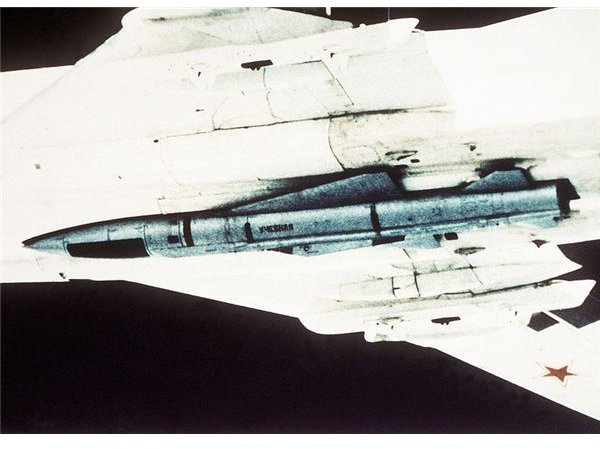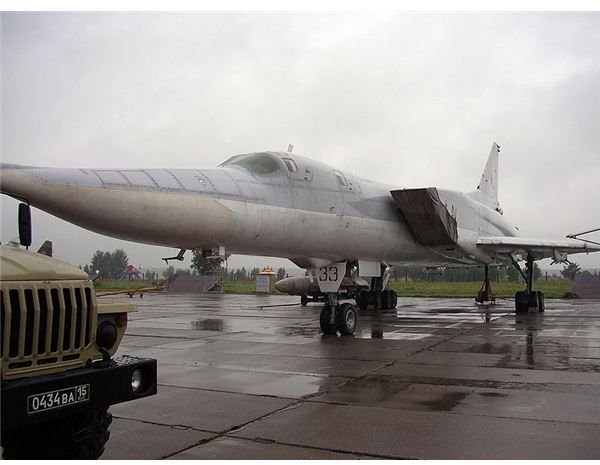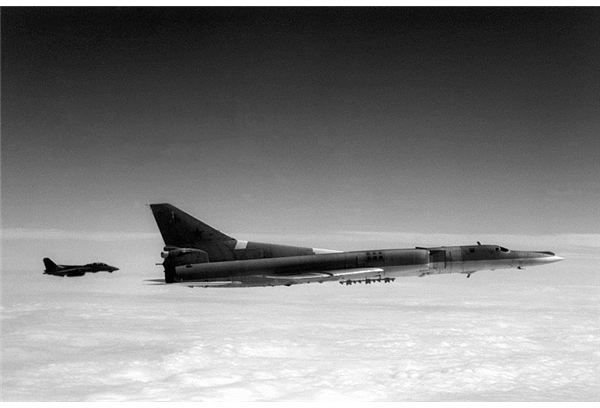Supersonic, Nuclear Capable, and Lethal: The Tu-22 M "Backfire"
The Cold War Heats Up, and Conventional Weapons Become the Focus
Throughout the 1950s and much of the 1960s it was assumed that any future conflict between the Soviet Union and United States would rapidly escalate to include the use of nuclear weapons. Because of this, both sides engaged in a nuclear arms race that would eventually lead to tens of thousands of warheads being deployed on hair trigger alert around the world.
But the Vietnam war and a series of border clashes between the Soviet Union and the People’s Republic of China showed that superpowers might still fight more traditional, conventional conflicts involving tanks, planes, and ships. The Cuban Missile Crisis too demonstrated the dangers of relying on nuclear deterrence alone. So by the mid to late 1960’s both superpowers began to develop new generations of conventional weapons and moved to compete with one another in the air, on land, and at sea.
Bombers by this time were becoming ever more vulnerable to surface to air missiles and fast interceptors. But they were still considered to be valuable long range strike aircraft and a key part of a nations’ nuclear deterrent. Even as the Cold War opponents began designing a new generation of conventional weapons they both realized that their traditional big, slow, high altitude bombers were no longer capable of surviving in a rapidly changing military environment.
The Soviet Union had an additional problem. In addition to needing an airframe to replace the aging Tu-16 Badger and Tu-95 Bear models in the nuclear strike role some kind of counter had to be developed for the growing threat posed by United States carrier battle groups at sea. The Soviet Union’s sea based deterrent on board ballistic missile submarines could be threatened by US carriers operating near to the Soviet coast. The Soviet Navy was no match for the US Navy and so the Soviets felt at risk of losing both their aerial deterrent and submarine deterrent if a war broke out. A weapons system was needed that could both fend off US carrier groups and deliver nuclear strikes.
Long Range, Variable Geometry Wings, and Nuclear Missiles
The Soviet answer to this challenge was the Tu-22. A long range bomber with wings that could be swept back or forward to change the aerodynamic qualities of the airframe and powerful jet engines equipped with afterburners and capable of supersonic flight, the jet was intended to be a missile carrying platform that was fast enough to evade air defenses long enough to deliver a potent nuclear or conventional payload onto a target.

However, the first models of the Tu-22 to be built were, to put it bluntly, nearly junk. Code named the “Blinder” bomber by NATO, the original design was sleek and fast, but lacked range and was dangerous to fly. Of course, in the Tupolev Design Bureau’s defense, it was the first Soviet attempt at building a supersonic bomber, and its design harkened back to the late 1950’s when the danger of conventional conflict seemed remote relative to a nuclear exchange. Regardless, it wasn’t what the Soviets needed.
The aircraft that came to be known as the Tu-22 “Backfire” was superficially related to the “Blinder”, but at best the aircraft should be regarded as cousins. The Backfire, often designated the Tu-22M to distinguish it from its predecessor, rectified the problems of the original airframe and fulfilled the needs of the Soviet Union. The salient characteristics of the Backfire include:
- Just under 140 feet long and over 36 feet tall, with a wingspan that can vary from 112 feet unswept to 76 feet swept
- Four crewmembers, over 136 tons maximum takeoff weight
- Powered by two afterburning jet engines with a max speed of about mach 1.9 and a combat radius of around 1500 miles without refueling
- Up to six nuclear missiles carried internally or three large antiship missiles carried internally and externally. Alternatively, over five dozen 250kg (about equal to 550 lb) bombs can be carried
Missions Performed by the Backfire
The Tu-22 Backfire performed two primary missions within Soviet and later Russian service. First, it had its nuclear strike role. For this the Backfire is currently typically equipped with half a dozen Kh-15 (NATO reporting name AS-16 Kickback) nuclear missiles each packing a several kiloton nuclear warhead. At least, this missile was to equip the aircraft later in the 1970’s - the Backfire first flew in 1969, and the Kickback wasn’t in full service until almost a decade later. Prior to the deployment of the Kh-15 it is likely that the Backfire was simply equipped with anti-ship missiles carrying one megaton nuclear warheads. Regardless of its particular loadout, as a nuclear bomber the Backfire was a lethal platform that generated a good bit of concern in the west.
But the Tu-22M’s most significant effect was in its service with Soviet Naval Aviation. There the aircraft was loaded with anywhere from one to three AS-4 Kitchen (Soviet designation Kh-22) anti-ship missiles. These

weapons were, simply put, beasts. Capable of flying at mach 4 and delivering a thousand kilograms (more than one US ton) of high explosives, the Soviet missiles were a huge threat to US carriers. Although long range, high speed cruise missiles had been deployed on the older Badger bombers, the supersonic speed of the Backfire meant that if it had a target location provided by a scout or submarine, it could dash within range of a carrier battle group at supersonic speeds, unleash up to three deadly missiles, and jet away at even higher speeds to avoid interception. Even if the Backfire was five hundred miles from a carrier group (which was possible with the use of airborne radar) it would be nearly impossible to scramble fighters and intercept a Backfire that would launch missiles 200 nautical miles from its target and reach this launch point a mere two minutes after detection.
The deployment of the Tu-22 Backfire changed the game at sea. If a multi-billion dollar aircraft carrier could be overwhelmed by flight of aircraft and missiles that together cost a fraction as much as the carrier, the US Navy suddenly became a far less effective instrument of national policy.
Legacy of the Backfire and Current Uses
Although the Backfire can’t receive all the credit, it is clear that the development of the F-14 Tomcat and its AIM 65 Phoenix missile system was influenced by the deployment of the Backfire-AS4 combination. Capable of engaging up to six targets a hundred miles away, if the Tomcats couldn’t hit the Backfires before they launched they could at least take out some of the inbound cruise missiles.
The deployment of AEGIS equipped naval vessels such as the Ticonderoga class cruisers and Arleigh Burke class destroyers was intended to counter the scenario of backfires saturating a carrier group with cruise missiles. With the possibility that a formation would be facing several hundred missiles simultaneously, the AEGIS system was pressed into service to provide the command, control, and response times necessary to combat weapons that could strike three or four minutes after launch.

The Tu-22 is still in service with the Russian Air Force as of 2011, and still fulfills the same roles as it did during the Cold War, albeit with more modern missiles and fewer total aircraft deployed. Fortunately, the Cold War never turned hot and the Backfire was never thrown against US Carrier groups. In fact, virtually the only instances where the Backfire has been used in combat have been against insurgents in Afghanistan and Chechnya or against the US equipped army of the nation of Georgia in 2008. With the end of the Cold War it can be hoped that this deadly weapon will never fulfill either of its intended uses: as a killer of aircraft carriers or a deliverer of nuclear fire.
Sources and Image Credits
Sources:
A Wordsworth Colour Guide Modern Warships; 1993 Wordswordh Editions LTD
The Great Book of Fighter Planes, 1990 Beekman House
Janes Air Launched Weapons: https://articles.janes.com/articles/Janes-Air-Launched-Weapons/Kh-15-RKV-15-AS-16-Kickback-Russian-Federation.html
Felix K. Chang at the Foreign Policy Research Institute: https://www.fpri.org/enotes/200808.chang.russiaresurgentgeorgia.html#ref6
Images: Courtesy of the US Department of Defense (Images 1,2,3) and Wiki Commons user Jno (Image 4), all accessed via Wiki Commons
